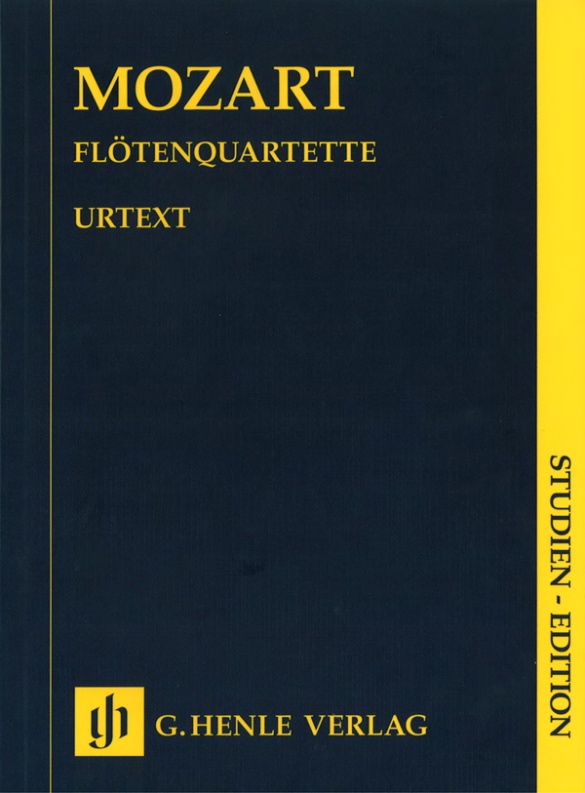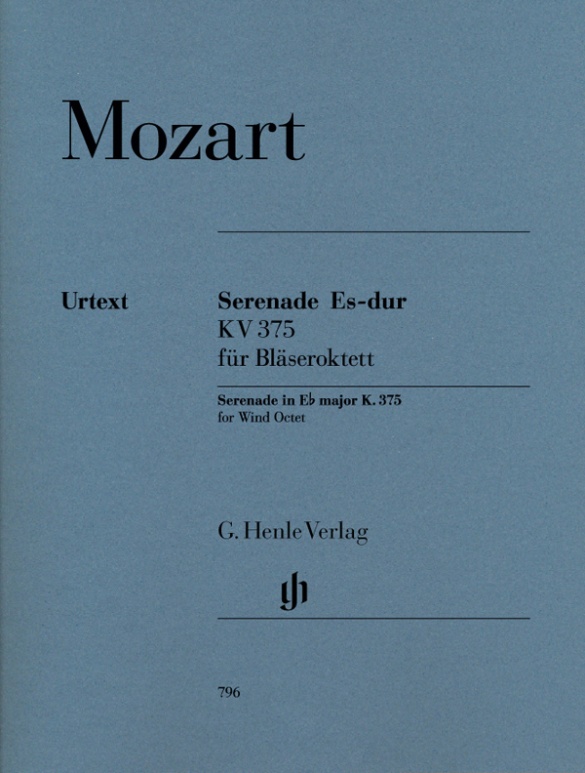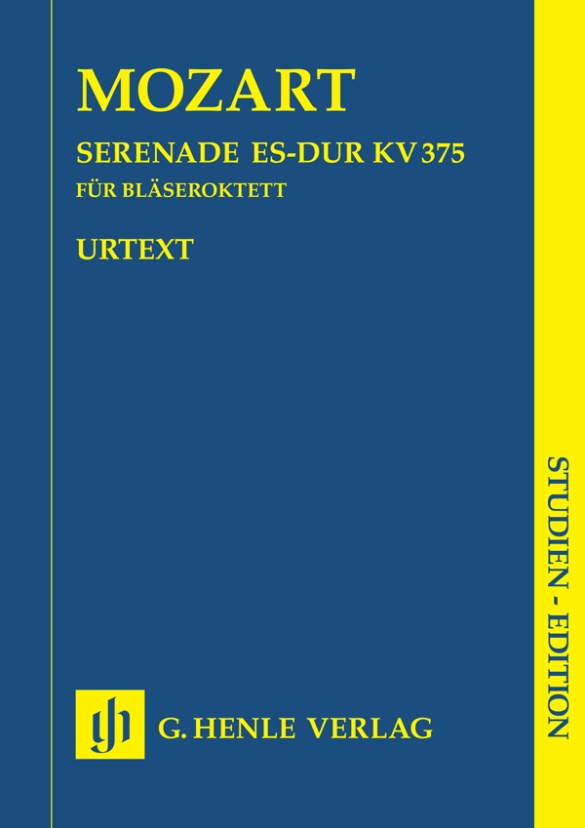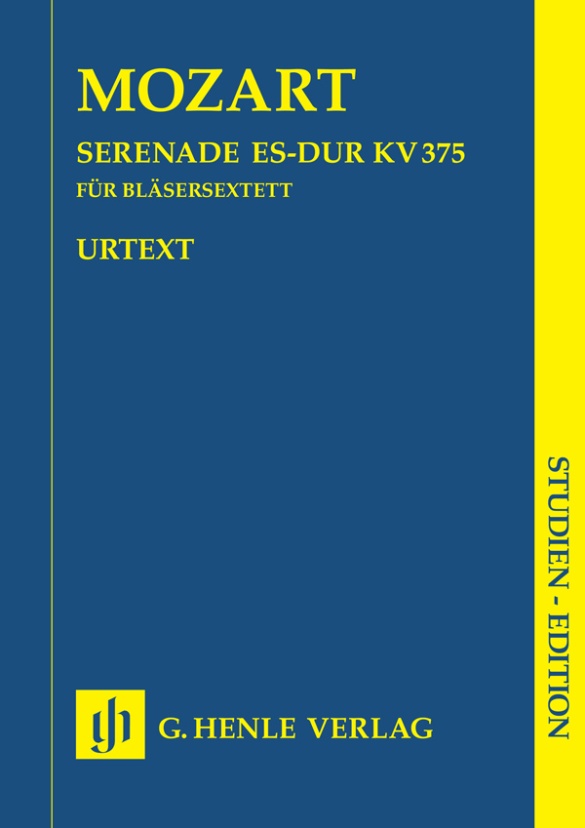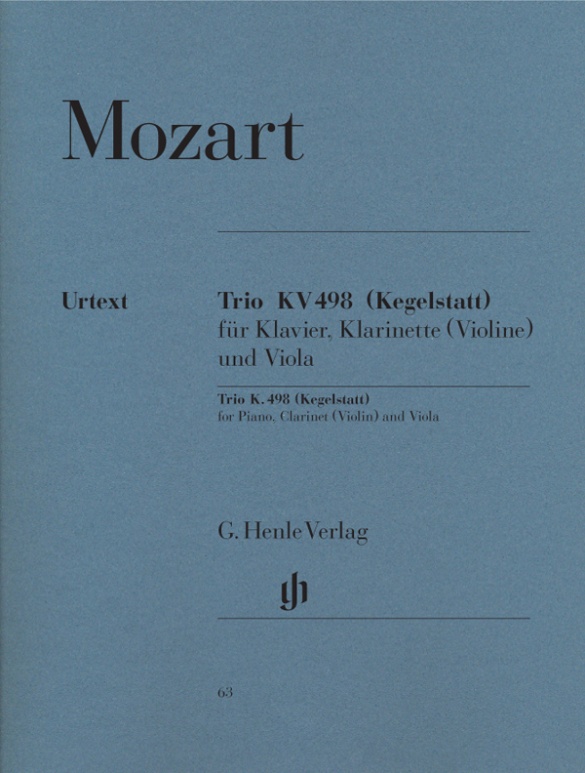

Wolfgang Amadeus Mozart
Trio en Mi bémol majeur K. 498 (Kegelstatt)
Cette œuvre composée avec tant d’ingéniosité serait-elle née effectivement au jeu de quilles? La légende est solidement ancrée, mais elle n’est étayée par aucune source autorisée. La composition instrumentale inhabituelle est en tout cas frappante; le fait de remplacer le violon par la clarinette était certes courant pour les trios avec piano; cependant, Mozart remplace en outre le violoncelle par l’alto, son instrument de prédilection. L’alto reçoit ainsi une partie beaucoup plus importante que celle impartie normalement au violoncelle. Notre édition séparée de cette œuvre légère et enjouée est extraite du volume déjà existant consacré à tous les trios avec piano (HN 247) et révisé conformément aux critères des connaissances musicologiques les plus actuelles.
CONTENU/DÉTAILS
CONCERNANT LE COMPOSITEUR

Wolfgang Amadeus Mozart
Mozart est l’un des rares compositeurs à avoir produit des œuvres exemplaires dans tous les genres musicaux. Grâce à ses tournées de concerts entreprises de bonne heure il a recueilli de multiples et diverses impressions musicales (Londres, Mannheim, l’Italie, Paris) qu’il a assimilées au cours de sa jeunesse et qui ont contribué à forger son langage musical jusqu’à son accomplissement.
| 1756 | Né le 27 janvier à Salzbourg, fils du musicien Leopold Mozart, plus tard compositeur de la cour. Un enseignement très précoce de la musique, sous la férule de son père, à partir de 1761 et premières compositions à l’âge de 5 ans. |
| 1763–66 | Assez longues tournées de concerts dans diverses villes allemandes et à Paris, Londres, Amsterdam, en Suisse. Il compose ses premières sonates pour violon et piano K. 10-15, dédiées à la reine Charlotte, de même que les premières symphonies K. 16, 19, écrites à Londres, qui traduisent l’influence des œuvres de Johann Christian Bach et Karl Friedrich Abel (forme tripartite de la Sinfonia italienne). |
| 1767 | Création à Salzbourg du Singspiel sacré «Die Schuldigkeit des ersten Gebotes» («Le devoir du Premier commandement») K. 35 (composé avec Michael Haydn et Anton C. Adlgasser) et de l’Intermède «Apollon et Hyacinthe» K. 38. Voyage avec son père et sa sœur à Vienne. |
| 1768 | Création (peut-être) à Vienne, du Singspiel «Bastien et Bastienne» K. 50. Composition de ses premières messes. |
| 1769 | Représentation du dramma giocoso «La finta semplice» K. 51 à Salzbourg. |
| 1769–71 | Deux voyages en Italie; il rencontre entre autres Farinelli, P. Nardini et le père Martini; rencontre avec Hasse lors du second voyage. Création à Milan en 1770 et 1771 de l’opera seria «Mitridate, Re di Ponto» et de la festa teatrale «Ascanio in Alba». Composition de symphonies et du 1er Quatuor à cordes (1770, K. 80). |
| 1771 | Composition de l’oratorio «La Betulia liberata» K. 118 à Salzbourg et en Italie. |
| 1772 | Création de la Serenata drammatica «Il sogno di Scipione» K. 126 pour l’intronisation de l’archevêque de Salzbourg Hieronymus comte Colloredo. Mozart est engagé et appointé comme Konzertmeister de la chapelle de la cour de Salzbourg (dont il était membre gracieux depuis 1769). Troisième voyage en Italie avec son père, création à Milan du Dramma per musica «Lucio Silla» avec un bon succès. Le dernier voyage en Italie marque la fin de sa jeune phase d’appropriation: il s’est exercé dans tous les genres instrumentaux importants (symphonie, sonate, quatuor à cordes) et dans tous les genres courants de l’opéra (Singspiel, opera buffa, opera seria, festa teatrale). |
| à partir de 1773 | Composition de quatuors à cordes (K. 168-173) sous l’influence de Haydn, de symphonies, divertimenti, sérénades. Sollicité par ses tâches de service, il se consacre plus intensément à la musique sacrée; plusieurs messes voient le jour. Il se lance dans la composition de concertos pour violon et pour piano. |
| 1775 | Création à Munich du dramma giocoso «La finta giardiniera» et de la Sérénade «Il Rè pastore». Sonates pour piano K. 279-284. |
| 1777 | Il quitte provisoirement son poste et entreprend, pour se faire connaître, un voyage avec sa mère à Munich, Mannheim et Paris. |
| 1778 | Composition de la Symphonie parisienne en Ré majeur (K. 297). Il assiste à Paris à la querelle entre Gluckistes et Piccinnistes. Édition de sonates pour violon. |
| 1779 | Il reprend son service à Salzbourg en tant qu’organiste de la cour. Messe du Couronnement en Ut majeur. |
| 1781 | Création à Munich de la tragédie lyrique «Idoménée» qui réalise une symbiose entre des éléments français et italiens. Voyage à Vienne. Après sa rupture avec l’archevêque de Salzbourg, il démissionne et déménage à Vienne où il gagne sa vie en tant que compositeur indépendant et par une activité de concerts et d’enseignement. Sa dernière grande période créatrice vient de commencer. |
| 1782 | Il apprend auprès du baron van Swieten à connaître les œuvres de Bach et de Händel; sur ce il arrange les fugues de Bach et introduit dans ses œuvres le «style savant» (fugue et contrepoint) aux côtés du «style galant» (entre autres les Quatuors à cordes en Sol majeur K. 387, en 1782; la Sonate pour piano en Fa majeur K. 533, en 1786; la Symphonie Jupiter K. 551, en 1788; La «Flûte enchantée» et le Requiem en ré mineur K. 626, les deux en 1791). Création à Vienne du Singspiel «L’Enlèvement au sérail». Composition de la Symphonie Haffner en Ré majeur K. 385. |
| 1738 | Messe en Ut mineur K. 427, Symphonie «Linz» en Ut majeur K. 425. |
| 1784 | Quatuor «La Chasse» en Si bémol majeur K. 458. |
| 1785 | Création de l’oratorio «Davide penitente» K. 469 à Vienne. Quatuor en Ut majeur K. 465 («Les dissonances»). |
| 1786 | Création de la comédie avec musique «Der Schauspieldirektor» (Le Directeur de théâtre) K. 486 dont Salieri triomphe avec son œuvre concurrente «Prima la musica e poi le parole». Création à Vienne de l’opera buffa «Les Noces de Figaro» dont les sections finales à l’action interminable constituent l’apogée de l’opéra bouffe. Symphonie «Prague» en Ré majeur K. 504. |
| 1787 | Sérénade en Sol majeur K. 525 (Une Petite musique de nuit). Il est nommé compositeur de chambre impérial et royal. Création à Prague du dramma giocoso «Il dissoluto punito ossia Il Don Giovanni» (Don Juan) dans lequel fusionnent l’opéra sérieux et l’opéra comique. |
| 1788 | Composition des grandes symphonies en Mi bémol majeur K. 543, en Sol mineur K. 550 et en Ut majeur (Jupiter) K. 551. Quintette pour clarinette en La majeur K. 581. |
| 1790 | Création à Vienne du dramma giocoso «Così fan tutte ossia La scuola degli amanti». |
| 1791 | Création à Prague de l’opera seria «La Clémence de Titus» et à Vienne du Singspiel «La Flûte enchantée». Concerto pour clarinette en La majeur K. 622. Le Requiem demeure inachevé. Il meurt le 5 décembre à Vienne. |
About the Authors
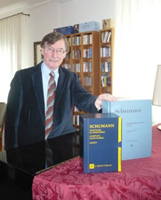
Ernst Herttrich (Editeur)
Dr. Ernst Herttrich, born in 1942 in Würzburg, read musicology, history, German and theology at the universities in Würzburg and Cologne. In 1970 he earned his doctorate in Würzburg with a study of the expression of melancholy in the music of Mozart.
From 1970 to 1990 he was an editor at G. Henle Publishers in Munich, after which he was Head of the Beethoven Complete Edition for over 15 years. In 1999 he took over as Head of the Beethoven-Haus Publishers, and from 2001 was made Head of the Beethoven-Archiv, the research centre at the Beethoven-Haus.
He has been a visiting professor at Meiji Gakuin University in Tokyo and has undertaken several lecture tours both there and to Kyoto. His research interests include source studies, editorial techniques and music history. Herttrich’s publications include “Beethoven. Liederkreis an die ferne Geliebte” (Bonn 1999) and “Ludwig van Beethoven. Biographie in Bildern” (Bonn, 2000). Herttrich has edited over 100 Urtext editions for G. Henle Publishers.
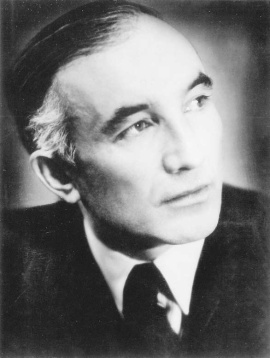
Hans-Martin Theopold (Doigtés)
Prof. Hans-Martin Theopold, was born to a pastor’s family in Detmold on 22 April 1904, the youngest of five children. Even as a child he often played the organ in the “Marktkirche” and soon began to take piano lessons with Theodor Vehmeier. At the age of 17 he made his debut at the Landestheater in Detmold with Ludwig van Beethoven’s Piano Concerto in C major under Friedrich Quast (Herford). Following the successful completion of his schooling at the Gymnasium Leopoldinum in Detmold, he went on to study music and piano (main subject): from 1922–23 at the “Württembergische Hochschule für Musik” in Stuttgart (with Max Pauer, 1866–1945) and then from 1923–1928 at the “Staatliche Akademische Hochschule für Musik” in Berlin-Charlottenburg (with Richard Rössler, 1880–1962, and Waldemar Lütschg, 1877–1948). After completing his piano studies (graduating with “very good”) in 1928, he began an active solo career both at home and abroad (USA, Switzerland, Scandinavia, the Baltic states, the Balkans). As a member of the Chamber Music Association of the State Opera in Berlin (from 1933) he also gave countless chamber music concerts, including ones with his violin partner Gustav Havemann (1882–1960).
In the 1930s, audiences and the press alike raved about Theopold’s extraordinary gifts as a pianist: “This young player has it in him to soon become one of the best players in Germany. A superior technique, a wonderful singing piano tone, the strength of a Titan, but not at all hard due to the incomparably gentle elasticity of his touch” [Münchener Zeitung, 21 November 1933]. – “H.M. Theopold gave convincing proof of his splendid pianistic ability in an extremely gripping sonata with a modern idiom by Alban Berg, but predominantly in Schubert’s […] Wanderer Fantasy, which he played with a polished technique and creative power” [Weser-Zeitung, 21 December 1932]. Theopold was awarded several prizes, including the “Grotrian-Steinweg-Preis” in 1928.
In 1937 Theopold became a teacher for the piano (main subject) at the “Bayerisches Staatskonservatorium der Musik” in Würzburg. In 1939 he married Irene Tatjana Wülfing, who was from Moscow. From 1943 he became head of the piano master-class at the “Nordische Musikschule” in Bremen, although this was interrupted by the events of the war. Following his return from a prisoner of war camp, Theopold gave concerts and taught although he did not hold a permanent position. From 1955–1956 he was acting head of the piano master-class at the “Bergisches Landeskonservatorium” in Wuppertal, finally being appointed Professor for Piano on 1 April 1956 at the “Staatliches Institut für Schul- und Volksmusik” in Detmold, later at the “Nordwestdeutsche Musikakademie Detmold” (today “Hochschule für Musik Detmold”), where he taught for decades. On 30 September 1969 he retired. “His students extol his pedagogical gifts. […] Humour, charm, helpfulness and kind-heartedness moderate the strictness of his professional ethos as a musician and teacher” (Lippische Rundschau, 23 April 1969; see also: Lippische Landeszeitung 22 April 1969 on the occasion of Theopold’s 65. birthday: “Prof. Theopold, a modest but at the same time energetic man, is an enthusiastic teacher”). Theopold died in Detmold in 2000.
Contact with Günter Henle was established directly after the publishing house was founded, when Theopold thanked the publishers with great enthusiasm for its first Urtext editions. His extensive correspondence with the publishing house was bequeathed to the Lippische Landesbibliothek in 2014 to ensure its long-term accessibility to the public. The letters testify not only to Theopold’s great interest in musical sources and text questions but also to his initial strict refusal (!) of fingerings in text-critical editions such as these: “For fingerings are and remain something individual no matter what their quality” (letter to Günter Henle from 26 May 1949 {publishing house archives}). Günter Henle was not, however, to be swayed and stressed the necessity of fingerings in his Urtext editions: “It is better to publish the Urtext […] with fingerings that are not necessary for a few individuals, or that might even, I admit, be considered irritating here and there” (letter to Hans-Martin Theopold of 17 September 1953).
It was only in 1955 that Theopold accepted Günter Henle’s offer of contributing fingerings for an Urtext edition that was in the process of being prepared by way of trial. (HN 74, Schubert, Complete Dances for Piano, Volume 1). Following this, Theopold was commissioned to write the fingerings for nearly all of the publishing house’s new editions in quick succession. Günter Henle, himself a good pianist, greatly valued Theopold’s fingerings, and also the many suggestions regarding the musical text in question. In addition, Theopold was always very reliable, thorough and conscientious – something that is not unimportant with editorial work!
Thus to date Hans-Martin Theopold has provided the fingerings for the greatest number of Henle Urtext editions by far – 226 editions (!) in total.
We would like to thank Mrs Margot Theopold and the Hochschule für Musik in Detmold for their great support in providing biographical material.
G. Henle Verlag
Informations sur la sécurité du produit

G. Henle Verlag
Vous trouverez ici des informations sur le fabricant du produit.G. Henle Verlag e.K.
Forstenrieder Allee 122
81476 München
Allemagne
info@henle.de
www.henle.com
recommandations
autogenerated_cross_selling
Autres éditions de ce titre
Autres éditions de ce titre


